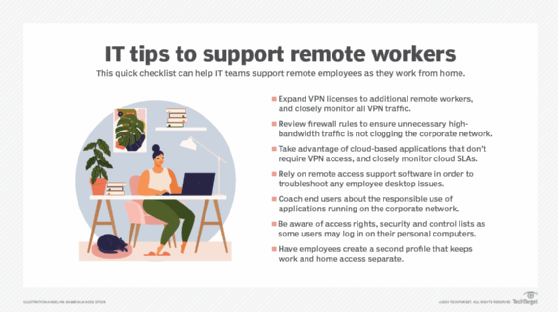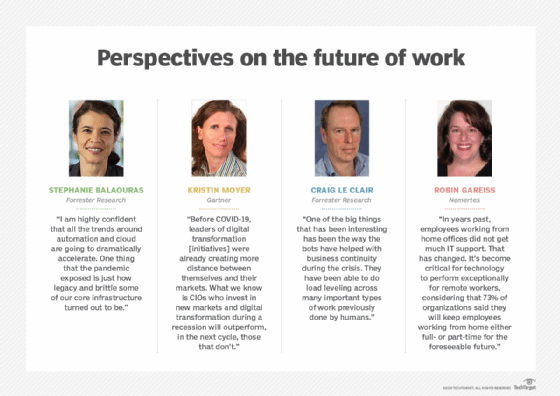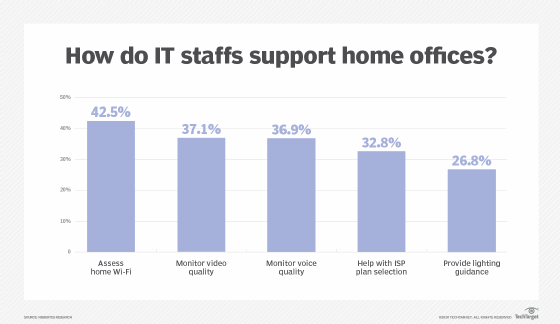The IT thought leader's guide to the future of work
Forward-looking IT leaders aren't waiting for the post-COVID-19 era to happen. They're shaping the technology trends and processes that will support future work environments.
The new normal, the next normal, the great reset -- what the future of work looks like beyond the profound disruption caused by the coronavirus pandemic can't be predicted with certainty. But business and IT executives can be confident of this: Successful leaders don't wait for the future to happen to them. To paraphrase a widely credited maxim of modern leadership, the best way to foretell the future is to create it.
The current state is certainly daunting. COVID-19 has infiltrated almost every country in the world, and both case counts and deaths from the virus continue to increase rapidly. Economists polled by Reuters expect the global economy to fall 4.0% in 2020, or by about $3.4 trillion, roughly the equivalent of the combined economies of Canada and Australia. The U.S.'s nearly 10% drop in GDP in the second quarter of 2020 was the largest on record, more than double that during the Great Recession. Moreover, the workplace shutdowns and remote work arrangements enacted in March by many companies persist -- both Google and Facebook, for example, plan to let employees keep working remotely until July 2021. Up to 30% of employees currently working from home will become permanently remote, according to Forrester Research, and many more will have a mix of in-office and at-home days. Life and business post-COVID-19 will not pick up where we left off.
Amid the turmoil, IT and business executives fortunate enough to have a role in steering their enterprises forward have a thrilling opportunity before them: to do everything in their power to build the technology infrastructure and business processes that will support the future of work.
This guide to future of work trends looks at how C-suite thought leaders are busy inventing the way forward, and includes an examination of the following:
- technology trends that are accelerating rapidly due to the pandemic, such as digital operating platforms, cloud computing, AI and zero-trust security;
- industry norms on the wane and possibly headed for extinction; and
- new enterprise trends, such as RPA and other types of automation, that are destined to become standard operating procedures.
Throughout the report, you'll find links to TechTarget articles that dig deeper into the fast-evolving trends shaping the future of work. The links will be updated continually as that future comes into clearer focus, so plan to check back frequently.
Digital transformation accelerates
IT was not immune to the spending cuts inflicted by COVID-19. Worldwide IT spending is widely predicted to decline in 2020, with the research firm IDC, for example, projecting a decrease of 5.1% versus the 5.1% increase in spending predicted at the start of the year. However, IT infrastructure spending is still projected to grow overall by almost 4%, according to IDC, bolstered by "resilient spending from IT service providers and enterprise demand for cloud services." Moreover, the intense focus in recent years on digital transformation strategies and the tools that support them, including cloud-based applications, mobile technologies, robotics and AI, remains strong.
"In the long term, this won't disrupt the general trend toward digital transformation -- in fact, it might just accelerate it," IDC analyst Stephen Minton told TechTarget. Minton said he believes the coronavirus pandemic will in fact provide "proof points" that companies further along in digital transformation were best positioned to withstand the crisis.
His view is consistent with that of enterprise leaders at Dell, PwC and grocery deliverer Peapod, who recently described their companies' aggressive efforts to pursue digital transformation initiatives in a TechTarget article on evolving IT strategies and future of work trends published last month:
- At Dell, an 11-year effort to give employees the tools they needed to work away from the office went into warp speed after March, resulting in 90% of its workforce equipped to work remotely as of July, up from just 60% at the start of the year.
- PwC's digital transformation initiative, now in its third year, is focused on training its 276,000 employees in the digital skills required to meet the needs of the company's consulting and professional services clients.

Companies that failed to equip their employees with digital tools have found it difficult to serve customers during the pandemic, said Forrester analyst Nigel Fenwick, labeling digitally mature companies as "predators" in the new world order created by COVID-19 and the laggards as "prey."
"The strong will get stronger, and the weak will get weaker," Gartner analyst Kristin Moyer concurred, noting that the pre-pandemic leaders in digital transformation were already "creating distance between themselves and their markets." She advised organizations that hadn't committed to accelerating digital technologies prior to the pandemic to do so now if they're able.
Short-term tactics, long-term IT strategies for 'transforming the core'
Indeed, one of the weaknesses the pandemic has exposed "is just how legacy and brittle some of our core infrastructure turned out to be," Forrester analyst Stephanie Balaouras said in an interview on future of work trends. A number of Forrester clients were "truly unprepared" to send employees home, Balaouras added.
"They had to scramble to buy laptops. Their infrastructure for identity management was so complex they had to use hardware -- they weren't prepared to use software for two-factor authentication," she said. At many companies, "huge weaknesses in scalability, performance and security" were laid bare.
The upside? A lot of business executives were "actually shocked" by the state of their technology infrastructure and newly committed to "transforming the core," Balaouras said. "For IT, this [pandemic] has been a shot in the arm for everything that had to happen."
Prepare to be shocked: 4 workforce changes to be ready for
COVID-19 is driving changes in how work is done and how workforces are supported by IT, but it isn't the only force that's disrupting the status quo, according to Forrester Research. In a June 2020 report, the consulting firm described the pandemic as "an acute symptom of a larger set of factors that were already poised to alter the way your workforce does its job."
The report, co-written by five Forrester analysts and titled "The Executive's Guide To The Future Of Work," identified four ongoing "shocks" that are reshaping work environments:
- increasing systemic risks, such as COVID-19 and climate change;
- the growing use of robots, AI and other automation tools;
- a "tsunami" of employee data, offering possible benefits and the potential for misuse; and
- heightened employee power in the workplace based on personal values.
But technology and management tools that can help foster "a maximally adaptive workforce" are available now, the report added. It cited employee experience tools, human capital management software, a Forrester-created robotics quotient to measure automation readiness and "human-centric leadership" built around a common set of organizational values.
--Craig Stedman, Editor at Large
Still, finding a balance between meeting the acute needs of the business during this crisis and executing on the long-term IT strategies required for future success won't be easy for CIOs and their IT teams, especially those in industries hit hard by the economic downturn caused by the pandemic.
But experts agreed that in addition to the short-term tactics deployed by CIOs to support ongoing work during the pandemic -- such as pressing vendors to renegotiate IT contracts, providing collaboration tools like Microsoft Teams and Zoom, and beefing up network bandwidth -- now is the time to invest in the technologies and skills that build resiliency in the face of systemic risk, including future epidemics and environmental disasters. The toolbox and skills, familiar to most CIOs, include the following:
Public and private cloud. In the next two to five years, Forrester expects to see widespread adoption of public cloud-based services and supporting cloud technologies -- such as microservices, serverless computing, containers and Kubernetes -- that can also be deployed in private cloud environments, according to a July 2020 report.
AI and process automation. Enterprise adoption of AI will continue to grow at businesses that have the resources to deal with the complexities of AI projects. For example, IT leaders at credit scoring company FICO and HR management software vendor ADP recently told TechTarget they are prioritizing how to find workers with the right AI skills.
The use of AI virtual assistants for customer support has surged during the pandemic, particularly in the healthcare and financial sectors. Other industries hit hard during the pandemic, such as travel and hospitality, are expected to make more use of virtual assistants to handle customer needs when business returns.
The use of virtual reality, augmented reality and mixed reality to train employees and assist workers in the field also rose sharply in recent months as the pandemic curtailed person-to-person collaboration.
The aggressive adoption of RPA pre-pandemic to automate routine business processes will continue apace, experts said, with RPA and its integration with AI techniques predicted to give rise to new job roles, including bot resource managers, automation engineers and chief efficiency officers.
Data science. Industry analyst Piyanka Jain made the case that in times of limited resources, a robust data science practice is crucial to identifying the projects that will yield the greatest return and mitigate risk. Jain's piece, "How data science can help your company withstand the pandemic," explains the "four Ds" of developing a data culture:
- data literacy
- data maturity
- data-driven leadership
- data-driven decision-making process
A word of caution on predictive models developed to improve operational efficiency, customer relationship management and financial performance prior to the pandemic: The sudden and dramatic changes wrought by COVID-19 have undermined the accuracy of many predictive models, experts warn. Learn about how to ensure predictive model accuracy in this TechTarget tip.
The radical adjustments to CIO agendas made during the early days of the pandemic, coupled with the successful efforts to quickly get workers up and running remotely, make it clear that IT teams were able to pivot effectively in the face of an unprecedented crisis. The challenge for CIOs and business leaders going forward is how to make the speed and agility demonstrated under pressure the enterprise's new normal.

Future of work trends in HR management
HR, perhaps more than any other function in the enterprise, understands that going back to the way things were before COVID is not in the cards. The important role of HR during the pandemic cannot be overstated. From the first outbreaks through tentative workplace re-openings to the reevaluation of return-to-work policies as flareups occur, HR teams have taken the lead in managing the impact of COVID-19 on employees. In the early weeks of the pandemic, HR professionals did the following:
- got up to speed on contact tracing technology critical to containing virus outbreaks;
- consulted with their CISOs on the privacy and security concerns raised by using these contact tracing platforms;
- navigated government programs that could help employees;
- worked with management to adjust corporate policies on furloughs, layoffs, vacations, sick pay, performance reviews, and hiring practices in the wake of the pandemic and after widespread calls for racial justice; and
- partnered with IT to make HR systems available remotely 24/7 so that company updates are easily accessible to employees.
Also, at some businesses, HR leaders quickly shifted to virtual hiring. At cable provider Spectrum, for example, the transition to virtual hiring took about a week and is now at 100%. "The first time that someone actually meets another human being in our process [is when] they pick up their laptop to start their job," Spectrum VP of recruiting Jennifer Tracy told TechTarget. "And then they take their assets home and work from home." In another article, Mark Feffer, an HR technology writer and editor of HCM Technology Report, detailed four strategies for optimizing your virtual recruiting process
Remote work full speed ahead?
The recommended practice of social distancing to contain the spread of COVID-19 meant that corporate work, almost overnight, became an activity that happened at home. How much longer remote work continues due to the current crisis, or to what extent it becomes permanent when the pandemic is under control, is an open question. But the unprecedented shift of labor from office to home provides insight into future of work trends.
For starters, remote work has largely gone better than expected, even boosting productivity, prompting speculation that remote work is here to stay. For example, a Gartner survey in June of 127 company leaders from HR, legal and compliance, finance and real estate found that 82% of respondents intend to permit remote working some of the time as employees return to the workplace. Nearly half (47%) said they intend to allow employees to work remotely full time going forward.
In her article on effectively managing IT teams working from home, Nemertes Research president and founder Robin Gareiss explained that a major factor in making remote work a success is equipping IT teams with the right infrastructure to manage all the other new home offices, including: business-grade internet, access to protected systems, and a technology kit that -- along with the standard cell phone, laptop, headset, etc., of knowledge workers -- includes two monitors for effectively troubleshooting employee issues. Beyond the training provided to resolve technical issues, IT staff now also needs to be trained on techniques for dealing with remote workers.
Not surprisingly, companies with existing remote work policies, and the technologies and skilled IT teams to support remote workers, had an easier time making the leap, according to interviews with more than 60 C-suite executives. But the executives also stressed that management's ability to be transparent and empathetic and to praise and inspire employees was as critical to keeping employees focused on work as having the necessary technical apparatus.

In fact, it is becoming increasingly clear that the emotional well-being of remote employees must be factored into every enterprise's pandemic business continuity plan, along with the business impact analysis, risk assessments and investment in new technology typical of BCDR plans.
Additionally, if, as expected, remote work is widely adopted after the pandemic, employees will have more flexibility in where they can take jobs, leading to a highly competitive job market in fields where demand is high. Just as "customer power" revolutionized customer service strategies, Forrester and other consultancies are predicting that "employee power" will force itself on companies, making employee experience a corporate priority.
To be sure, the full-time remote office worker trend has its doubters, who point to the clumsiness of Zoom meetings and the strong preference for working face to face as just two deterrents. More typical, however, is the perspective of Facebook co-founder and CEO Mark Zuckerberg. He has stated that up to 50% of the company's 45,000 employees could be permanent remote workers in five to 10 years, even as the social behemoth recently secured a lease for 730,000 square feet of office space in Manhattan.
Security and ERM: Reimagined for the future of work
Whether 50% or 10% of your employees become permanently remote, the future of work requires organizations to permanently change how they protect corporate assets.
In a July 2020 report on COVID-19 risks, the World Economic Forum reported that rapid unplanned digital transformation of business, especially in retail, education and healthcare, has increased the risk and impact of cyberattacks. As offices closed, criminals turned their attention to remote workers; 50% of enterprises surveyed expressed concern about increased cyberattacks due to a shift in work patterns alone.
Protecting against rising threats won't be easy. Network-based security tools deployed within corporate networks typically did not travel home with employees, who tend to ignore office security policies when working from home. And the security measures and tools remote workers do have in place are likely insufficient to protect sensitive corporate data. But, as explained in this TechTarget article on securing a home network for remote workforces, there are five steps that organizations should take to mitigate risks.
Going forward, experts agree that the long-endorsed but minimally adopted zero-trust security model -- a philosophy based on giving users the least amount of access needed to accomplish a task -- must become a CISO priority in the world of remote work and digital ubiquity. Technologies that are critical to making it work include multifactor authentication, identity and access management, orchestration, analytics, encryption, scoring and file systems permissions.
Remote work has put the power and risk of a digital workplace in sharp relief, forcing businesses to make hard decisions about the tradeoffs between security and usability. But for companies that have been able to weather the coronavirus crisis, the forced experiment in moving operations to a virtual model will result in permanent change -- and, for many, an overdue reassessment of their enterprise risk strategies.
One shortcoming they will discover, according to Forrester's Balaouras, is that their approach to enterprise risk management (ERM) is highly siloed and continues to rely on manual processes. "ERM is a complete digital laggard," she said. "Most of it is done manually; there is not a lot of integration of external intelligence; there is not a lot of integration of contextual information about the business." That is ripe for change. As IT and business leaders forge an ERM strategy for the future of work, they will need to keep in mind the following: The systemic risk to businesses inflicted by the coronavirus crisis is unprecedented, but there will be other global crises in the future, and preparations must be made now.








